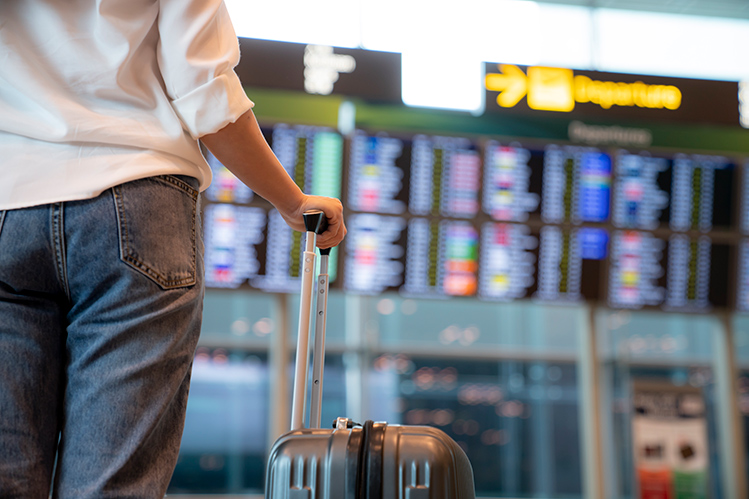An interview with Richard van Wijk, Global Aviation Practice Lead, Nokia. By Ross Falconer
The unprecedented impact of the COVID-19 pandemic on the aviation industry is changing airport security screening. Recent guidelines issued by ACI and ICAO, such as the Smart Security – Post COVID-19 Aviation Security Playbook, outline the need for airports to include health and thermal screening into their operations and overall next-generation digital strategy.
Airports worldwide need to upgrade their passenger screening systems to address COVID-19 and other health concerns. Current manual or supervised screening requires airports to commit significant personnel and resources, while constraining passenger flows and impacting the overall passenger experience.

Richard van Wijk, Global Aviation Practice Lead, Nokia
“Airports need a screening system that is accurate, scalable, and supports multiple queues,” explains Richard van Wijk, Global Aviation Practice Lead, Nokia. “The Nokia Automated Analytics Solution for Access Control (NAAS) is the first fully automated group triage solution for airports. It is far more effective and nearly transparent to the passengers.”
The solution enables airports to rapidly identify travellers with an elevated temperature, as well as those not adhering to health guidelines such as wearing face masks. It also includes automated real-time signage to direct individuals or families to appropriate countermeasures, while alerting safety personnel to intervene for follow-up only with at-risk individuals.
“It is cost-efficient as the staffing requirement is much-reduced compared to current passenger screening systems requiring manual guidance of passenger flow with typically at least two staff on rotation for each screening position,” says van Wijk. “The solution is applicable beyond COVID-19, so airports are making a long-term investment in safe operations. Overall, the solution enables contactless screening of passengers for improved airport safety.”
Improving passenger flow and enhancing airport access control
The Nokia solution supports multiple screening lanes with a single camera. Van Wijk explains that, compared to manual screening, it improves passenger flow by automating scanning of passengers and providing customised real time digital signage for regulating flows. “Fast detection of individuals and families helps to re-direct them using digital signage without impacting passenger flows and disrupting the need to maintain social distancing.”
Meanwhile, with current screening systems, collecting passenger statistics from multiple screening lanes is difficult and limits the effectiveness of optimal passenger movement airport-wide. “The Nokia NAAS counts triaged passengers and generates statistics on the incidence of elevated temperature at a screening location, from an aircraft, or over a time period,” says van Wijk. “It can also calculate the speed of passenger flow in a queue and trigger the activation of additional lines, or dispatch of personnel, to enhance line-serving efficiency.”
For airport stakeholders and employees, the Nokia NAAS can be adapted to other screening requirements such as personnel access to key operational areas. The solution can identify employees with elevated temperatures and be integrated with an access control badge system to automatically prevent facility access.
In terms of the key considerations regarding economics, van Wijk explains that the Nokia NAAS reduces screening costs on both infrastructure and staffing. “The payback period is typically less than a year for most medium to large deployments. The solution can be integrated for automated access control at the airport and be further adapted for other analytics applications. In addition, it can be used to generate revenues, for example, for providing passenger temperatures to airlines.”
Optimising operations and security monitoring
The Nokia NAAS solution can address more than COVID-19 health screening, including non-health-related airport analytics. “It helps airports optimise their operations and their security monitoring,” van Wijk comments. “For example, it can detect crowd build-up to help manage adequate physical distancing or determine anomalous traffic patterns and crowd movement in a specific location for early alerting of security to developing situations. The solution also leverages analytics to determine facility usage to turn down the HVAC in certain parts of the airport and save heating/cooling cost. It uses geofencing to detect unauthorised persons or vehicles in restricted or remote unmanned areas, while flow analytics identify the best spot to put the next digital signage for advertising.”
The Nokia “bring your own algorithm” approach means that the Nokia NAAS solution can be constantly improved and adapted to specific airport processes. It can function as an open analytics platform that interprets streaming data from a wide variety of IoT devices and cameras to improve operational efficiency and safety for both passengers and airport personnel.

As the aviation industry works on recovery, the contactless journey is a priority to restore the confidence of travellers.
Private wireless will be an essential platform
As the aviation industry works on recovery, the contactless journey is a priority to restore the confidence of travellers.
Thermal screening will play a role in improving security screening and regain back passenger confidence. “The Nokia NAAS is an innovative solution providing airports with an effective and cost-efficient way to achieving thermal screening and more,” says van Wijk. “We are looking forward to working with many airports on this.”
The recovery also means that airports could consider a shift from concrete investment to wireless-enabled digital innovation as a more affordable investment choice near-term. “Nokia has been at the forefront of industrial-grade private wireless networking with over 180 large enterprise customer deployments worldwide,” van Wijk explains. “Airports continue to digitize their operations in order to become an operationally excellent organization with the lowest cost possible. An increasing amount of operational applications will rely on wireless connectivity, as such, the wireless network becomes a critical asset for airports during their digital journey – connectivity cannot be treated as a commodity. Private wireless will be the essential platform to enhance airport operational continuity, enable operational excellence, enhance passenger experience, and improve financials.”
Cybersecurity is another important area that airports must continue to address to avoid operational disruptions and data loss. One barrier for airports is a lack of resources, which can also be compounded by insufficient budgeting for cybersecurity. Automation can help overcome these challenges and play a pivotal role in mitigating and resolving cyber-threats. Van Wijk adds that Nokia offers extensive expertise to turn airport cybersecurity from reactive to automated and proactive.
“In summary, besides the Nokia Automated Analytics Solution for Access Control, Nokia will continue our work with airports to make private wireless network a key strategic asset and to ensure cybersecurity.”







